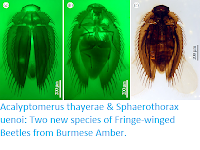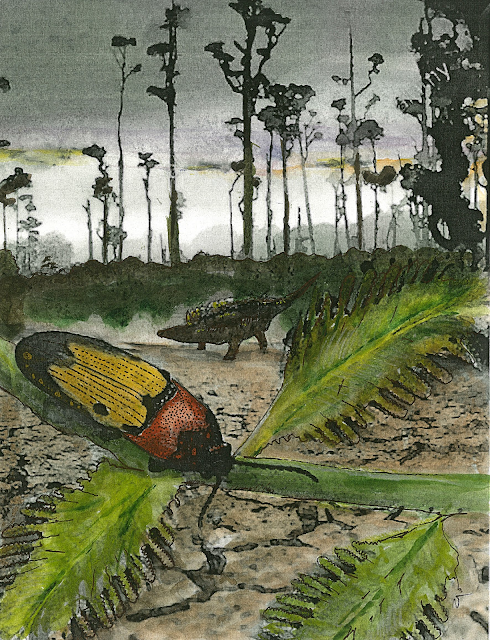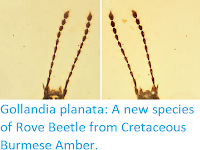Beetles, and Insects in general, are hyperdiverse modern organisms which play key roles in almost all modern ecosystems. They a have long fossil record, which are considered to be key to understanding the emergence and development of the various Beetle groups. However, compression fossils tend to preserve relatively little detail in Beetles, limiting their use to palaeontologists. Preservation in amber, on the other hand, often produces excellent fossil Beetles with detailed anatomical features preserved in three dimensions. However, the vast majority of the known Insect-producing amber deposits are less than 65 million years old, making Mesozoic amber deposits particularly valued, both for their rarity and for the information they provide. Important Cretaceous amber deposits are found in Lebanon, Israel, Jordan, France, England, Spain, the US, Canada, Russia and Myanmar, with the Burmese, Lebanese, Spanish and French ambers being particularly noted for the abundance of the Insect fossils they produce.
In a paper published in the journal Scientific Reports on 7 January 2022, Márton Szabó of the Department of Paleontology and Geology at the Hungarian Natural History Museum and the Department of Palaeontology at Eötvös Loránd University, Robin Kundrata and Johana Hoffmannova of the Department of Zoology at Palacky University, Tamás Németh of the Department of Zoology and Ecology at the Hungarian University of Agriculture and Life Science, Emese Bodor, also of the Department of Palaeontology and of the Institute for Geological and Geochemical Research at Eötvös Loránd University, Imre Szenti of the Department of Applied and Environmental Chemistry at the University of Szeged, Alexander Prosvirov of the Department of Entomology at Moscow State University, Ákos Kukovecz, also of the Department of Applied and Environmental Chemistry at the University of Szeged, and Attila Ősi, again of the Department of Palaeontology at Eötvös Loránd University, describe a Click Beetle, Elateridae, from Late Cretaceous Hungarian amber.
Amber is found in Hungary in the alluvial floodplain deposits of the Csehbánya Formation near Iharkút and the Ajka Coal Formation southeast of the city Ajka in the Bakony Mountains in southwestern Hungary, both of which deposits are Santonian in age (86.3-83.6 million years old). The ambers of the Csehbánya Formation are typically found as very small particles, and no significant inclusions have been found in them to date, whereas the ambers of the Ajka Coal Formation frequently contain preserved organisms.
The Ajka Coal Formation comprises an alternation of coal beds, carbonaceous to argillaceous pelitic sediments with interbedded molluscan lumachelles, marls, and sandstone beds representing a lacustrine-palustrine sequence. It is over a hundred metres thick in places, and produces a range of fossils including Plants, Molluscs, and Vertebrates. A variety of Arthropod fossils have been reported from amber from the Ajka Coal Formation, but to date only two species of Ceratopogonid Flies have been described to date.
Click Beetles are a large Beetle group related to the Fireflies and Soldier Beetles. They have elongate bodies, and a 'clicking mechanism' comprising a prosternal process which can be rapidly slid into their mesosternal cavity, producing an audible click and propelling them rapidly into the air, in a jump which enables them to escape predators. There are over 11 000 described species of extant Click Beetles, plus 261 fossil species in 99 genera. The group are commonly found as inclusions in amber, probably due to their habit of boring into the bark of trees, though few species preserved in this way have been described, implying that there are probably many more fossil species to be formally discovered; only three Cretaceous Click Beetles have been described from amber deposits, all from Kachin State in Myanmar.
The new species is named Ajkaelater merkli, where 'Ajkaelater' implies 'Ajka Click Beetle' and 'merkli' honours the late Ottó Merkl, a leading Hungarian entomologist, World renowned expert On Darkling Beetles, Tenebrionidae, and the long-term curator of the Coleoptera Department of the Hungarian Natural History Museum. The species is described from a single, fragmentary Beetle, of indeterminate sex, which lacks a head, from a piece of dark red amber. The specimen is not naked-eye visible, and was only revealed when the amber was subjected to micro‑computed tomography.
The specimen is about 6.5 mm long and 2 mm wide, and has an oblong-oval shape with subparallel, slightly convex sides. The head is missing, but part of one antennae is preserved. The pronotum (forward part of the thorax, in front of the part of an Insect to which the wings and legs are attached) is slightly wider than it is long, and is widest at its posterior angle. The elytra (wing-cases) are oblong-oval in shape.
Ajkaelater merkli is the first fossil Beetle described from Hungary (other fossil Beetles are known from the Miocene and Pliocene of Hungary, but have not been formally described). It is also the first Mesozoic Click Beetle reported from mainland Europe; some have been reported from the UK, but all other Mesozoic representatives of the group are from East or Central Asia, where the group is thought to have originated in the Triassic or Early Cretaceous. It is also the first Click Beetle reported from Santonian deposits anywhere in the world.
The larvae of modern Click Beetles are typically saproxylic, living in rotting wood, or sometimes leaf litter, organic rich soils or sometimes Mosses. All of these environments are likely to have been present when the Ajka Coal Formation was laid down, in a network of swampy forests and shallow lakes, making it likely that the larvae of these Beetles were already living in a way similar to their modern descendants.
See also...



Online courses in Palaeontology.
Follow Sciency Thoughts on Facebook.
Follow Sciency Thoughts on Twitter.






